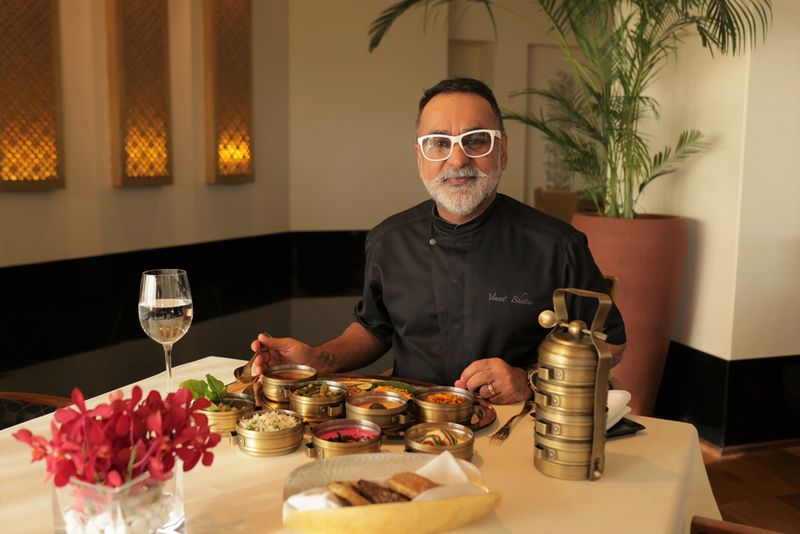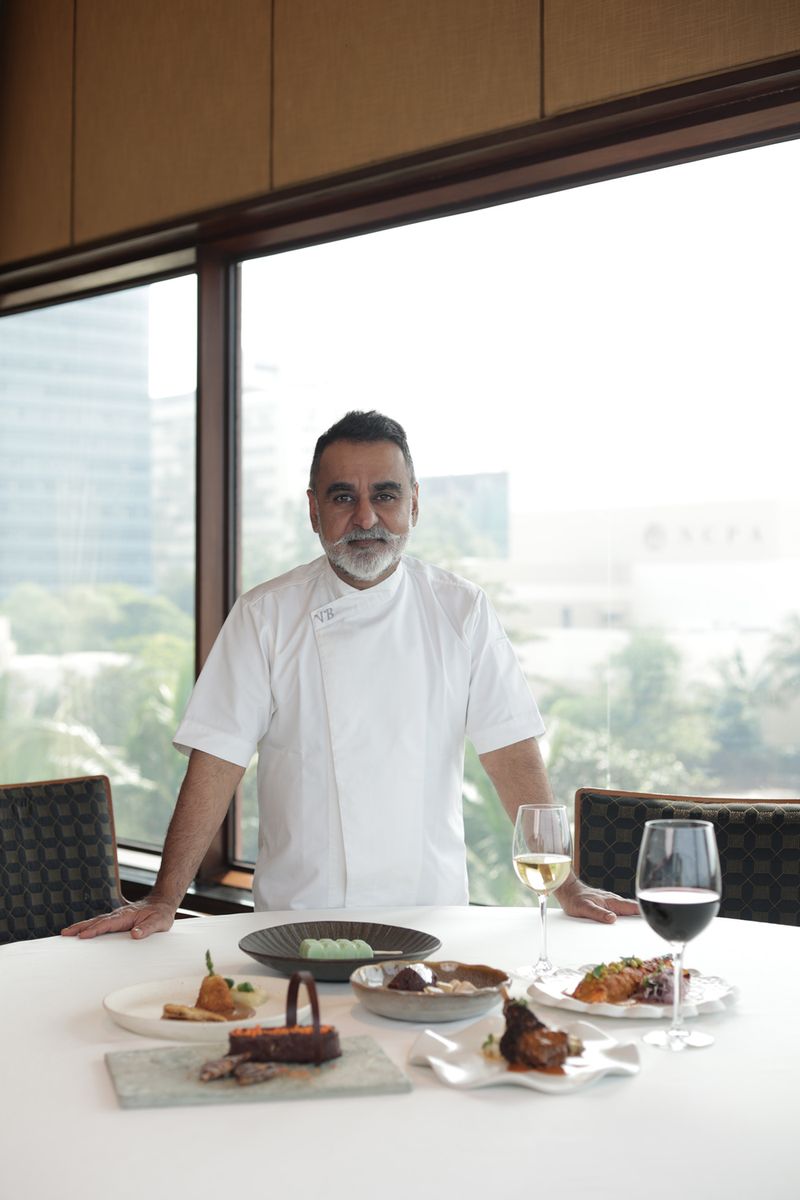We meet Vineet Bhatia over lunch during his quarterly visit to Ziya at The Oberoi, Mumbai. This trip, he tells us, is for quality checks and training. He has spent a few days at The Oberoi Delhi where Ziya is slated to open this year. His eyes glisten from behind his signature white-framed glasses, as he tells us about his visit to Sassoon Dock that morning.
That same evening, he is cooking for a celebrity friend who is performing in the city this weekend. Ed Sheeran? We guess. He smiles, letting us in on his plan to make him his own version of the Yorkshire pudding for the English songwriter-singer.

Bhatia, who has been featured on shows such as The Final Table (2018) and Master Chef India as judge, grew up in Mumbai and joined The Oberoi Delhi as a trainee in 1988. years later, he was appointed as Chef De Cuisine at The Oberoi, Mumbai (Mewar and Kandahar Restaurants).
In 1993, he moved to the UK to explore a culinary career on international waters and joined Star of India (Old Brompton Road, South Kensington). In 1999, he opened Zaika, which was awarded a Michelin star in 2001, making Bhatia the first Indian chef-restaurateur to receive this honour. In 2004, Bhatia opened his own restaurant Rasoi, which also received a Michelin star in 2006. Today he has 10 restaurants across UK, Saudi Arabia. Bahrain, Mauritius and India. Excerpts from the interview:
Congratulations on being awarded a Member of the Order of the British Empire (MBE) honour last year. How did this happen?
On December 21, 2022, I got a call from the British Ambassador to UAE. He began the call by asking me if I was seated. I wondered what it was about. I had made it to King Charles’s first list of Member of the Order of the British Empire (MBE) honour awarded for services in various fields. His next question was even more bizarre: Will you accept it? Of course, I accepted! I received the MBE for services to the hospitality and for promoting the best of British and Indian on an international platform.
Tell us about your early food days?
When I began my career in 1985, there was no avant garde cuisine. We turned to French for avant garde. Every aspiring chef wanted to cook Continental and French cuisine in the hopes to become an executive chef. I would see non-Indian chefs come to the hotel and cook their food using local Indian ingredients. I felt Indian cuisine didn’t have that ease. We packed in so much cream and masalas in our food to validate its richness in hotels. Restaurant food was missing the clean, shudh (pure) flavours.

How has the food scene changed since then?
Social media has changed the dynamics of food drastically. In earlier part of the millennium, many restaurants in UK took offense if you pulled out your phone to take a picture. Between the 60s and 90s, our lifestyle was not so sedentary. We cycled, we walked to our destinations and you worked in the house too.
Today, everything is at the tip of our screens. With technology, the dynamics of food and how we consumed it has changed. I was in Chandi Chowk last year, and 80–90-year-old establishments are now also serving dosa and vada pav on the menu. It breaks my heart but you have to understand that the owner has to make a living and feeding a trend; just like we are. In a few years, I will not be surprised if we see methi tacos in Chandni Chowk. Food changes dramatically overtime.
Indian cuisine lies at the heart of your cooking. Tell us about your approach.
Indian cuisine is so rich. I love to work with colours. Beetroot or chakundar is my favourite. People who are close to me often laugh that I am crazy about this root vegetable. I use it in lobster, south Indian tadka, soup, leftover rice, gol gappas, kebabs and even dessert. It is such a versatile, nutritious and humble ingredient but highly underrated. I love making a soup out of it with coconut milk and kadi patta. It is presented as a sol kadi but when you taste it, it’s a spin off.
Eating is all about engaging the senses. You find a dish visually appealing; you smell its aroma, taste its flavours, hear its crunch and feel the textures. When I opened Rasoi, one of the earliest dishes we had on the menu was Delhi-style aloo tikki dusted with flour for khastapan (softness), mildly seasoned barely spiced and pan fried. Topped with hari and imli chutney, it was served on a bed of chhole with a side of khattey pyaaz. This dish was a predecessor for our iconic samosa chaat.
What are the Mumbai food joints you visit on your trips.
A must visit on every trip is Shiv Pani Puri in Andheri when I visit my parents.
Do you travel for food?
A few years ago, my younger son Ronit and I went off on a local food experience in Argentina, Buenos Aires. We indulged in choripan asado sando, baguettes packed with red meats with choice of sauces. It is always interesting to see how the world treats its meats in ovens, spit fires, charcoal wood fires, etc. Indian cuisine is so rich in flavours that we are able to add layers and new dimensions. It is our strength, if used well.
Work also allows me to create with local ingredients all over the globe. In Venezuela, I worked with black potatoes, and black corn, executing a seekh kebab and makai ka shorba.
Any trends you don’t like today?
What I don’t like is chefs overdoing it with the garnishes. A confident chef will place one green to finish his garnish instead of turning it into a crowded chaos of cress.

Your recent menu at The Oberoi Concours d'Elegance at Udaivilas in Udaipur was inspired by the vintage car rally.
We did the opening dinner for 50 guests and we based our theme on vintage cars and Rajashtani food. My first course was a savoury ghevar spiced with masalas and topped with fried prawns. We also did a bhatti chicken filled with tomato chutney and coated with carbon powder and squid ink. This we served with bite-size gatta coins. The lamb chop was a take on laal maas, spiced with mathania chillies and spices. This was served with a 48-hour cooked gehu ( wheat grains) that imitated a glutinous khichdi. The presentation was European but every mouthful was a taste of Rajasthan. Our dessert, shaped like a car and named Vintage Dessert was most interesting: A chocolate car topped with almond mouse placed on sweetened choorma.
Are we any close to breaking the myth that India food is chicken tikka masala and butter chicken?
This is still a work in progress. Customers in big cities, like London, are open to expanding their Indian food dictionary. In 1993, I was told off for serving rogan josh with the bone on. Today, customers opt for food with bone because it is the best cut. We have come a long way.
The taste of Mumbai Tiffin is inspired by the iconic dabba and features Marathi, Parsi, Gujarati and Rajasthani dishes. At Ziya, The Oberoi, Mumbai; meal for two: INR 3,200


_1710933114168_thumb_1200.jpeg?w=3840&q=75)
_1710500209586_thumb_300.jpeg)